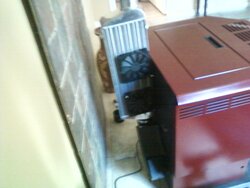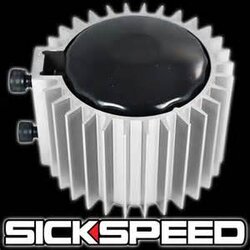I recently upgraded my santa fe with the coil springs and snap disc rewiring/relocation mods found here and I'm quite pleased with the results. I decided to try something a bit different with my cb1200 since it vents into the chimney and not the wall.
I used an automotive 3" intercooler and silicone hose connectors rated for 500 degrees along with 3" exhaust pipe. I also attached 2 fluid bearing silent fans that are activated by the combustion motor power. I run the stove on low with the slide almost open all the way, Lux thermostat with swing setting on 3. Intercooler exhaust in temp is about 250, the outlet side of the intercooler is 83 after 10 minutes.
Might not be for you but it seems to work well for me, modify at your own risk. I just wanted to share what I've done, I don't get on here much these days. I will try to answer questions quickly, but it may take me a while to get back to you.
The intercooler was on ebay $60 shipped, 2 silicone hose connections $15, 4-3" hose clamps home depot $4 and 2 fans from newegg $15pr.
Additionally, I used the 90 degree quadrafire exhaust adapter that has a nice hinged cleanout door with a 3" outlet.
I used an automotive 3" intercooler and silicone hose connectors rated for 500 degrees along with 3" exhaust pipe. I also attached 2 fluid bearing silent fans that are activated by the combustion motor power. I run the stove on low with the slide almost open all the way, Lux thermostat with swing setting on 3. Intercooler exhaust in temp is about 250, the outlet side of the intercooler is 83 after 10 minutes.
Might not be for you but it seems to work well for me, modify at your own risk. I just wanted to share what I've done, I don't get on here much these days. I will try to answer questions quickly, but it may take me a while to get back to you.
The intercooler was on ebay $60 shipped, 2 silicone hose connections $15, 4-3" hose clamps home depot $4 and 2 fans from newegg $15pr.
Additionally, I used the 90 degree quadrafire exhaust adapter that has a nice hinged cleanout door with a 3" outlet.



